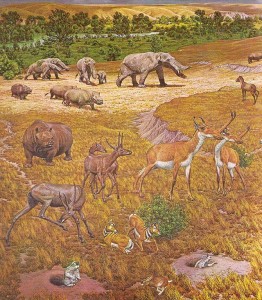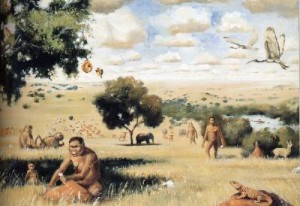Part III: Pliocene Epoch
THE PLIOCENE EPOCH (5.3–2.6 mya)

The Pliocene Epoch (~5.3–2.6 mya) was characterized by global cooling and weather disruptions due to the formation of the Panama land bridge and resultant changes in ocean currents. The polar ice caps were expanding and sea levels had already begun to drop, as the Pleistocene Epoch (~2.6 mya–11.7 kya) approached. The geologic record shows us that Africa was subject to cooling and drying trends, with seasons becoming more pronounced. Grasslands were expanding and thus forest cover was shrinking. Intermittent wet and dry periods changed the African landscape. Lakes formed and dried and filled once again. All of the ardipiths and most australopiths went extinct during this epoch and by ~2.0 mya genus Homo appeared in the fossil record. The most tantalizing question with regard to the earliest members of our genus is what drove the encephalization process. By the time of the more derived paranthropines [Paranthropus boisei (2.5–1.4 mya) and robustus (1.9–1.3 mya)] and genus: Homo (≥2 mya), cranial capacity had increased ~100 cc and 200 cc, respectively, from the earlier hominins. It has generally been hypothesized that competition for resources was the driving force, and while that may be so, recent research has illuminated just how radical climatic changes were in East Africa. The film Becoming Human (2009, Discovery Communications) provides a nice overview of how scientists have pieced together the Pliocene environment of that region of the world from the local geology.
PLIOCENE HOMININS

The Pliocene Epoch can be considered the time of the great adaptive radiation of the hominins, when more than a dozen species evolved in the hominin corridor from Ethiopia to South Africa. While the ardipiths died out, concurrent with the reduction in forest cover during the late Miocene and early Pliocene, many australopiths came and went over the course of almost 3 mya of the Pliocene. The australopith lineage may pre-date the Pliocene; there is possible australopith material (possibly Australopithecus anamensis or afarensis) from the late Miocene from several Kenyan sites (e.g. Lothagam and Tabarin) for which no taxonomic designation has been established. While there is debate as to how much time australopiths spent outside of forested environments, they certainly filled distinctive niches, as evidenced by changing craniofaciodental morphology as well as more versatile hands that afforded them greater manipulative abilities. As we discover more about australopith limb morphology, it is apparent that some were more adapted to an arboreal environment whereas others were less so. Of even greater interest is that the East African australopiths (i.e. Australopithecus anamensis, afarensis, and garhi) may represent a different clade than those from South Africa (i.e. Australopithecus africanus and sediba). The East African species may have been more adapted to a terrestrial environment, while the South African forms may have retained or reverted to more primitive climbing adaptations. The various species may have walked differently as well.
The question remains: from which group are we descended? Some researchers have suggested that Au. sediba from South Africa may be part of our lineage; this confounds matters for some researchers as to how the older East African species were seemingly less primitive in some ways than the more recent South African forms. We need to realize that we are only seeing part of the picture. Just as the ape population levels exploded on three continents in the Miocene, the same was apparently true for African hominins in the Plio-Pleistocene. Discoveries of new species of African apes and hominins are accelerating. We need to break out of our linear mindset and realize that there were numerous species adapting to localized conditions, so we should not expect to see uniform changes across time and geographic space. In addition, the same may hold true for grouping and mating practices. We should not jump to conclusions or get too caught up in how the various species were related and who begat whom! While everyone would like to be the person who found one of our long lost relatives, the history of paleoanthropology is fraught with those claims and debunks.

Upper limb morphology suggests that australopiths retained adaptations for climbing trees that were likely used for food and safety. However, when on the ground, they were habitual bipeds, albeit with some differences from ourselves.

